Updated 22 May 2014
A 1970's Teenager's Bedroom
Introduction:
This page shows some of the evolution of my stereo system and involvement with electronics as a teenager in the mid 1970s. The earliest pictures I have are from 1976, however I started with stereo systems in the early 70s. The photos below are in
chronological order.
Why this page?
At work and in related travels, I often get questioned as to how I got started in electronics. Basically I started playing with batteries and light bulbs at around age 7 (1967). From there things went somewhat slowly until around 1974 when I got into stereo systems. Rather than tell the detailed story many times over, I put together this page to illustrate how things got started for me.
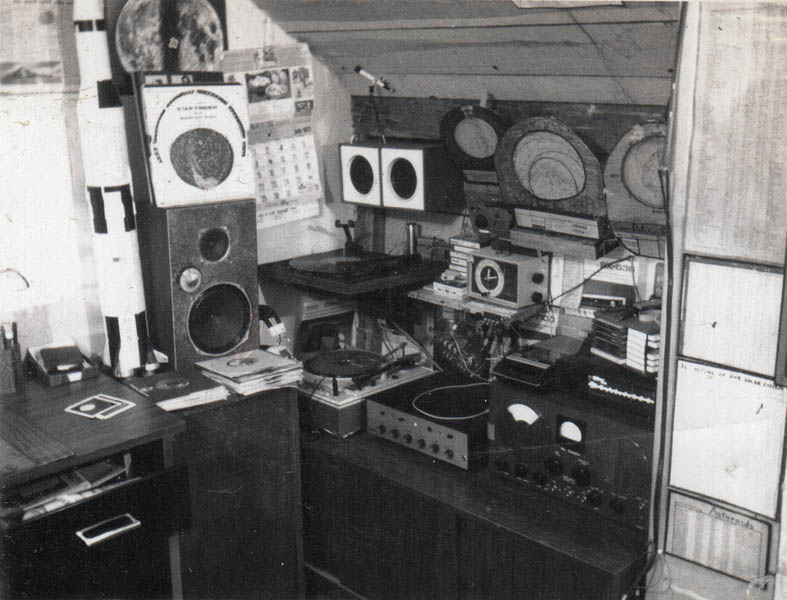
A shot of the corner of my bedroom with the stereo system from July 1976. A Harmon Kardon (Trio) tube amp is at the center of the system (this unit was 12 watts per channel). To the right of it is a Halicrafters short-wave radio. Above that is a Harmon Kardon (Rondo) mono tube tuner. The lower turntable is a modified GE phonograph. I got this phonograph in 1972 (had an old Grundig console before that but it died). When I got the Harmon Kardon amp, I had to find a way to wire the turntable to work with the amp (of course compact phono has no provisions for external connections). This was my first major (for the time) accomplishment, taking the phono and rewiring the cartridge output so that I could plug it into the amp. It worked! The other turntable (above the green GE) was a second one I obtained at a later time. The three items above the system are homemade "star dials", these were motorized planispheres that showed what stars were up at any given time. Two speakers can be seen here, and 8" two way and (below) a 12" two way system. The lower system is homebuilt. Note the Pioneer SX-636 literature on the wall behind the equipment!
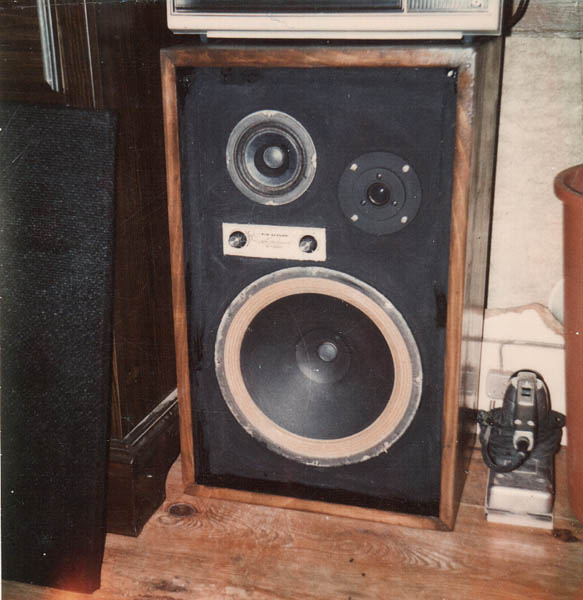
A photo of my newly upgraded speaker system. Previously it was a 12" two way system with a horn tweeter originally built in the fall of 1974. Now (October 1976) it has been upgraded to a three way system including a midrange and dome tweeter. The speaker components (woofer and midrange) are Radio Shack brand, however Utah made these speakers for Radio Shack. This system is all homemade, basically made of 1 x 12 pine boards cut with a skillsaw (I did not have any fancy woodworking tools at the time). This system is still in use today, it is fine for low power (up to 30 watts or so) listening.
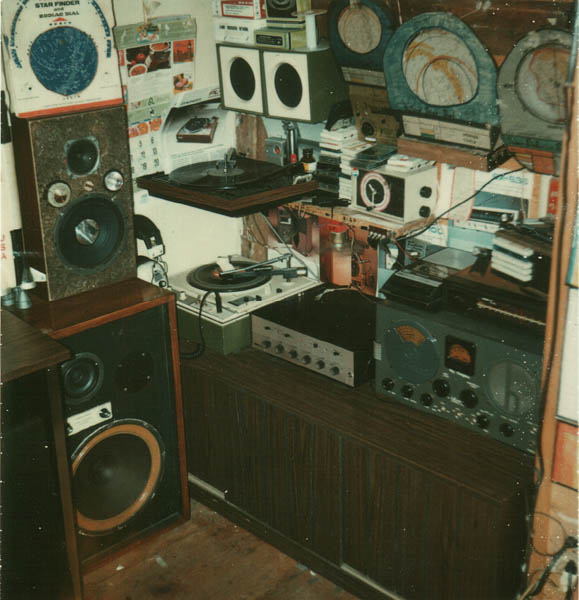
Another view of the system corner, this image is from late 1976. A new woofer can be seen in the 8" two way system. A fan has been installed under the shelf to keep the tube amp cool, it is powered by a train transformer mounted on the wall.
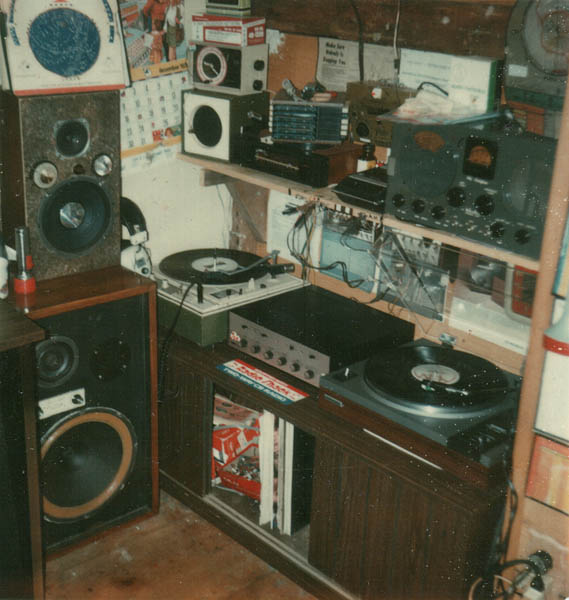
January 1977. A new Pioneer PL-112D turntable has been added (it was my big Christmas present for 1976). Had to re-arrange a number of items to accommodate the new gear. With the new turntable, my 45 record collection suffered much less wear (even though I had modified the old GE phono to track a lot lighter). It also sounds a lot better! One old turntable is now retired.
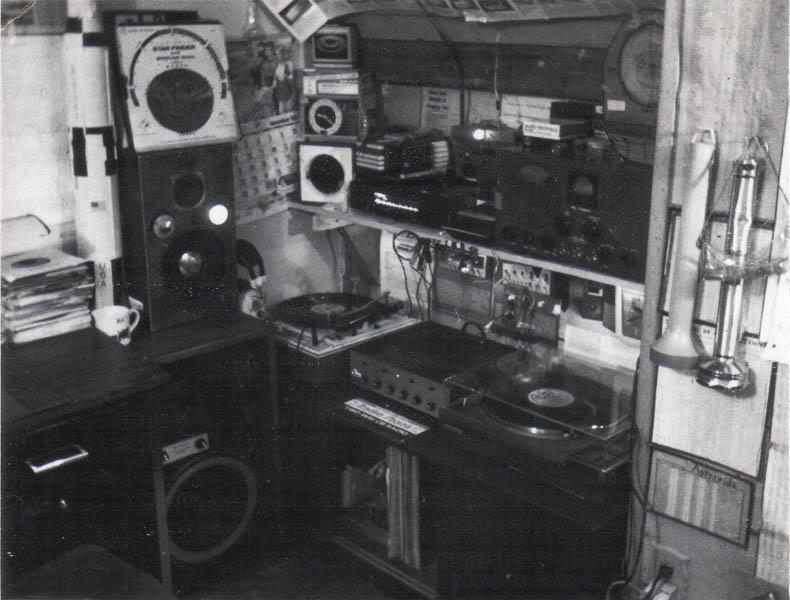
Another view from early 1977. Note the pile of 45 records on the desk. Also, the 8" speaker system has a light installed (for special effects). The bulb was wired in series with the woofer, and it flashed in accordance with the volume of sound. Problem was, it blew out too often!
Are you a speaker builder/audio hobbyist in need of parts?
Please check out Parts Express, a great source for all kinds of RF connectors, speakers, components, etc. I sure wish they were around when I was building speakers in the 70s, they have a HUGE offereing of components!
a great source for all kinds of RF connectors, speakers, components, etc. I sure wish they were around when I was building speakers in the 70s, they have a HUGE offereing of components!
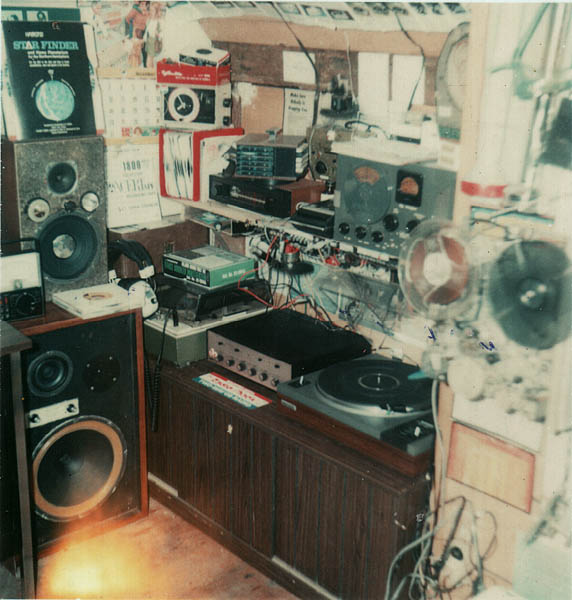
March 1977. An old Revere reel to reel recorder (salvaged from the town dump by my father) is now mounted on the wall. This unit was from 1957 and despite having no cabinet, worked quite well. It was only mono, but at 7 1/2 ips the sound was actually pretty good. I had this recorder up until around 1999 when I finally retired it permanently. 40+ years of service out of a piece of gear... most of the junk sold today would be lucky to last 1/3 that long. Things were built to last back then, this recorder was very well made and heavy. Also visible in this photo is a Realistic multitester. This item was very helpful in doing various measurements!
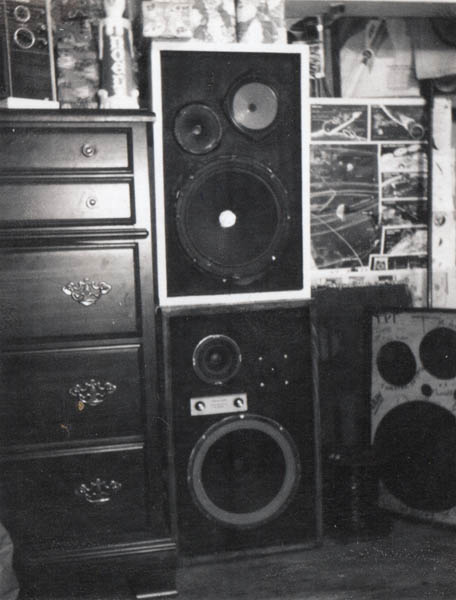
December 1976. A new 12" 3-way system made from speakers salvaged from the East Longmeadow MA town dump. One person's trash is another persons treasure! Speaker cabinet was made out of particle board and painted.
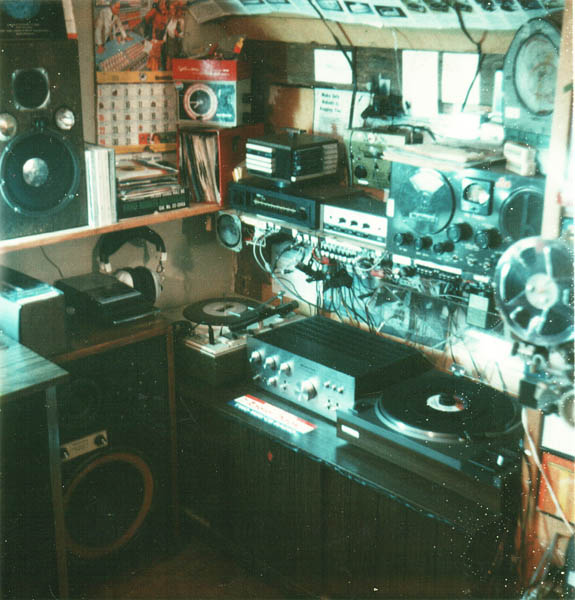
May 1977. A new Kenwood KA-3500 (40 watts/channel) amp has been added to the system as of 17 May 1977, a major upgrade from the old tube amp (both amps are still in service in 2008). I earned the money for this amp (price was $139.99 at Lechmere) by making a stone walkway. It was a LOT of work, had to locate and haul many large flat rocks to the area and set them in the ground. Probably moved about 5000 pounds of rocks to make this walkway, and it is still there today (as is the amp)! Also, a new shelf has been added to hold equipment that had to be rearranged. Also note that a Realistic SA-100C amplifier has been added. This amp was originally owned by my neighbor Paul Goewey, he later sold it to my brother and then I bought it after that. This amp was used for the Bugging System.
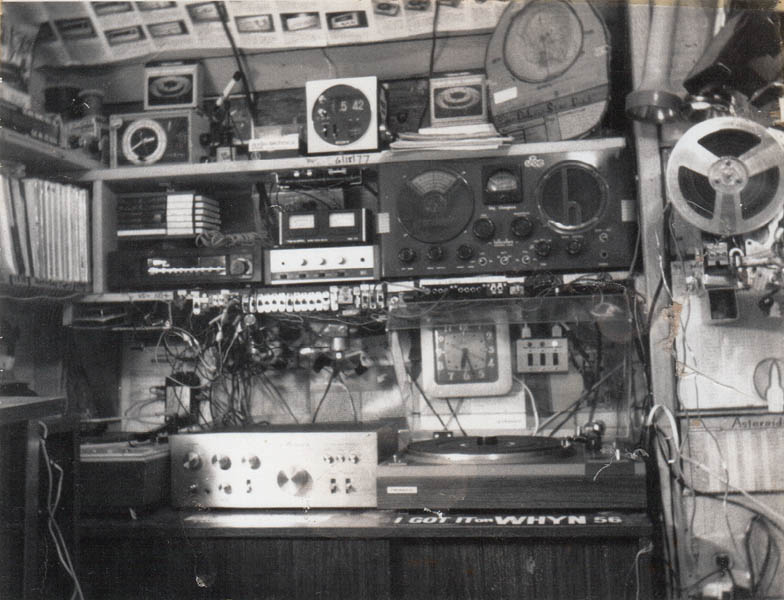
June 1977. Another layer of shelving (basically pine boards) has been added to support the added equipment. Power Meters for the speakers have been added as well. Mounted on the front of the shelf (right below a small Radio Shack amplifier) are a number of switches... these controlled what was known as the "bugging system". I had numerous (at peak about 12) speakers (which also functioned as microphones) wired all around the house and property. Using this system, I could monitor what was going on at remote locations, or send music to those same locations. This system was crude by today's standards, but overall it worked quite well considering what I had to work with. Note the power control switchbox on the wall above the Pioneer PL-112D turntable. This was used to control things like the fans that cool the amp, the bugging system, etc. Clock radios have also been rearranged somewhat due to the expanding system.
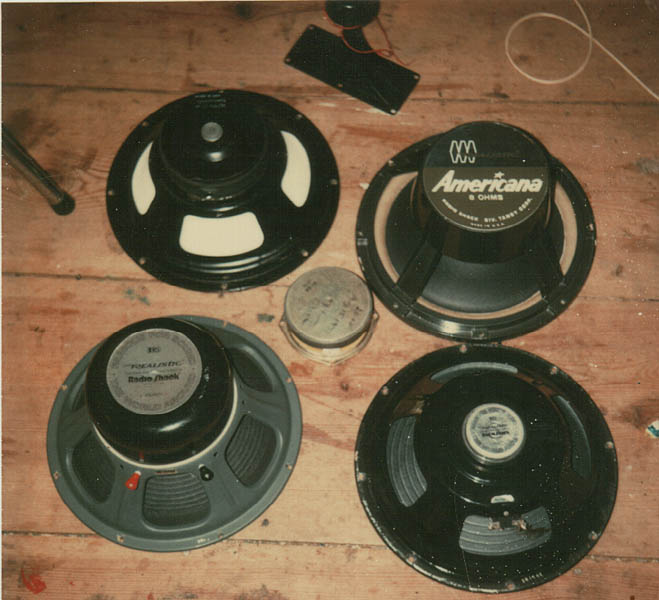
1977 photo. Some of the speakers that were installed in various speaker systems I made. At top left is a Philips 12" woofer with 40 oz magnet and 2" voice coil (a fine woofer for its day). At top right is a Radio Shack 12" triaxial speaker... actually, these were made by Utah and sold by Radio Shack under the Americana name. This speaker I got in summer of 1977 at a "Where-is-As-is" sale (does anyone remember those)? Unfortunately, they only had the one speaker, so I got it, hoping to locate another (I never did, but today on Ebay that are not uncommon). At the lower right is a 12" Radio Shack speaker that we used to call the "eight dollar woofer". It was a speaker with minimal capabilities, a 12" speaker with a 1" voice coil and a 5 Oz magnet, but it only cost $8! It was a great entry level speaker for those who could afford little but who wanted a "big" speaker sound. It was basically a Utah PA speaker. Finally, at lower left is a Radio Shack 12" musical instrument speaker. This too was basically a Utah speaker sold under the Radio Shack name. In the middle is an Olsen 5" speaker with 20 oz magnet. I used this as a midrange speaker for a while, however its sensitivity was way too much compared to the rest of the components so I changed it out for a Radio Shack dome midrange speaker in 1979.
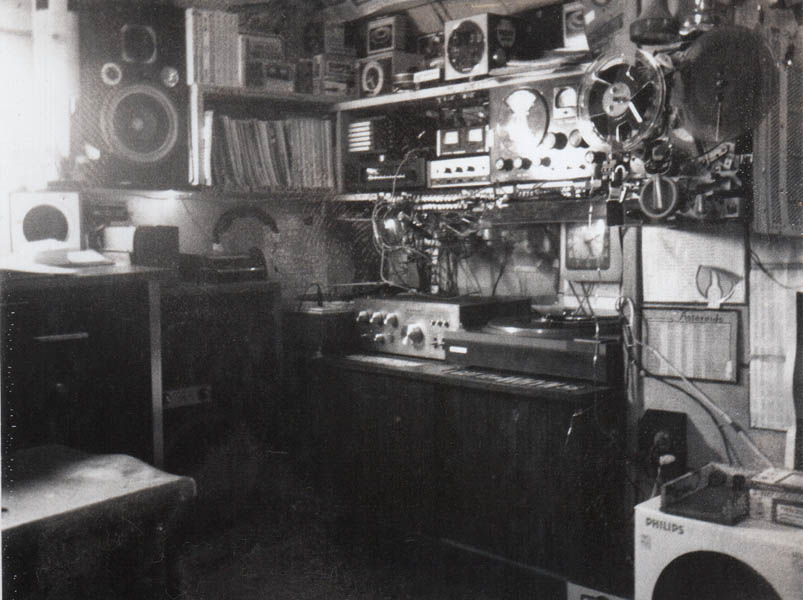
October 1977. The 8" two way system has been modified once again (now has a new woofer). The woofer is a Radio Shack 8" dual cone woofer. Like the 12" Triaxial woofer above, this was purchased at a Radio Shack "Where-is-As-is" sale. This speaker system is still in use today.
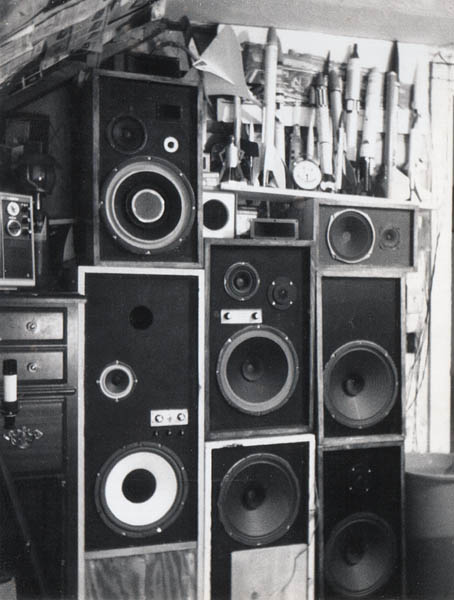
October 1977. The east wall of the bedroom, known as the "concert wall". Most notable here is the addition of my newest speaker system, the "Philips". This system used (naturally) a Philips 12" woofer with 40 oz magnet and 2" voice coil. This new system was much more powerful than any of the previous systems I had built. Above that is another 12" system that was built over the summer (it used the Radio Shack [Utah] 12" Triaxial speaker, however I disconnected the tweeter). Also seen are several speaker cabinets that use the Radio Shack "eight dollar woofer". The main problem with all of these speakers was the lack of sufficient power to drive them all (all I had at the time was about 50 watts per channel, and collectively all these speakers could have handled about 250 watts!). Still, this array generated some fairly serious sound for a small bedroom! Above and to the right of these speakers can be seen part of my Estes rocket collection.
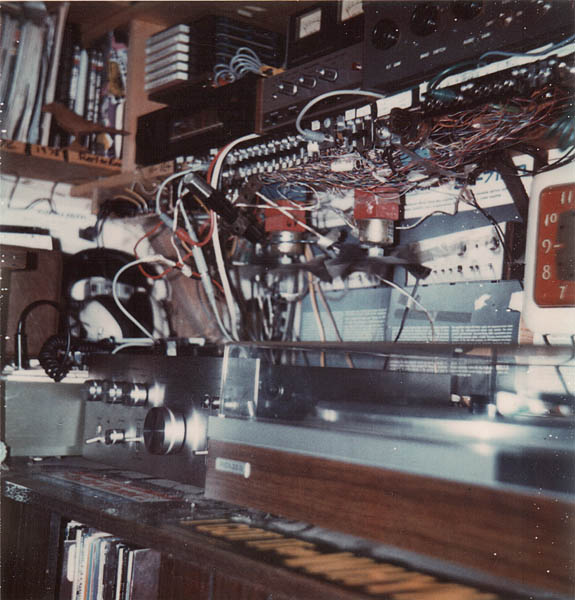
A view looking under the shelf to show some of the mass of wiring that made up the "bugging system". Note the microphone that was used to make announcements throughout the house and property. Also seen are dual cooling fans for the amp (not that the transistor amp got all that hot to begin with...). Literature for Pioneer stereo gear graces the walls behind the equipment.
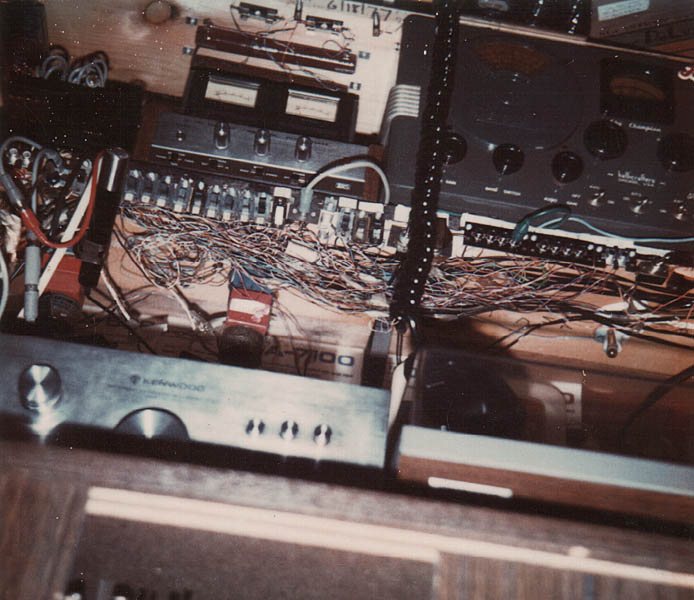
Another view of the wiring mass under the shelf. A patch panel can be seen to the right, this worked in a fashion similar to an old telephone switchboard. Note the fuses and large power resistor under the top shelf. This was used (incorrectly) at the time to help the amplifier drive 4 ohm speaker loads.
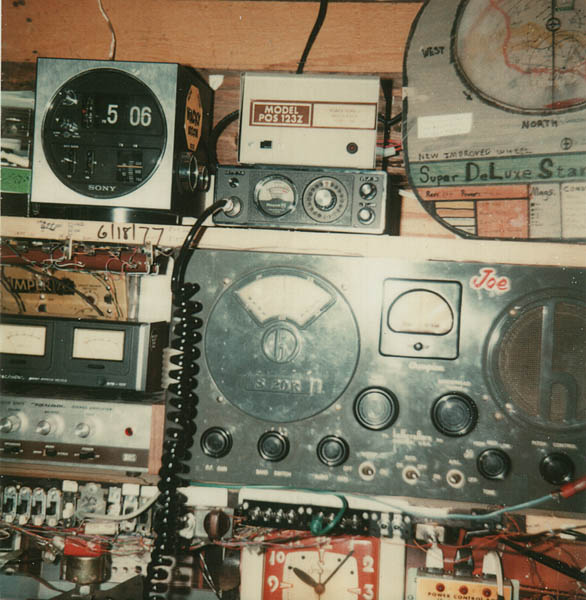
Late 1977, a 40 channel Royce CB radio (and 12 VDC power supply) has been added to the system.
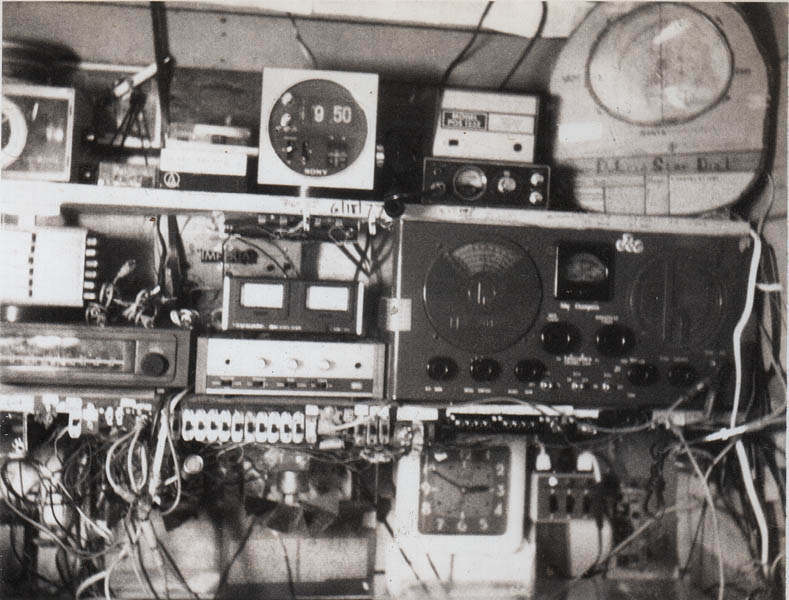
A wider angle shot from late 1977/early 1978. To the left of the clock radio can be seen a box for the Audio Technica cartridge that was used on the Pioneer PL-112D.
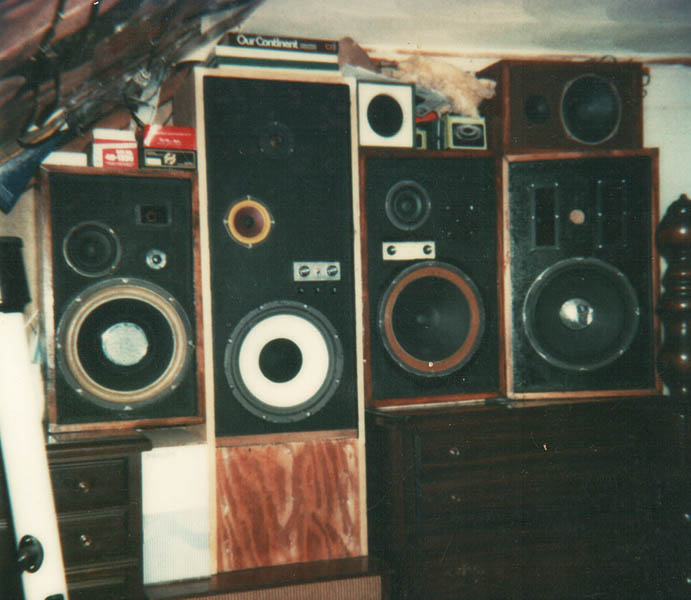
February 1978. The east wall of the room has been modified with another new speaker system. Some of the previous ones have been dismantled. A Tasco telescope can be seen at the far left of the photo.
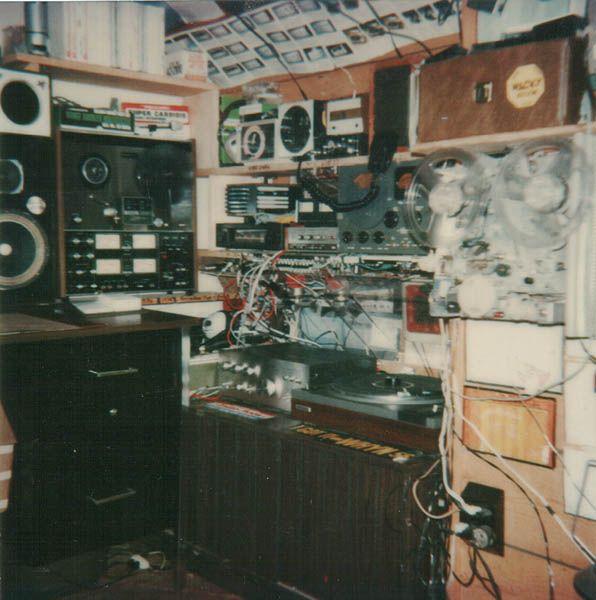
March 1978. A TEAC 2340 4 channel reel-to-reel recorder has been added. This unit was my father's; he hardly ever used it so I took it over after obtaining a new solenoid for it. This unit was a very luxurious item for a teen to have in the 1970's... new, these units went for around $1000 (a LOT of $$ back then)! The sound quality of the unit was very, very good, it will easily compete with the sound from a CD player. And, being a 4 track three head unit, it allowed for some fun editing and special effects. The only problem with having this unit is that when I did get a cassette deck I was so disappointed in the decrease in sound quality! People had talked about how great the modern cassette decks were... however, few (if any) could compete with a reel to reel machine of this caliber. A Nakamichi (big $$$$) could probably come close, but it simply cannot match or exceed the quality of sound these reel to reel machines put out! Also note the Pioneer fold out literature that is posted on the ceiling.
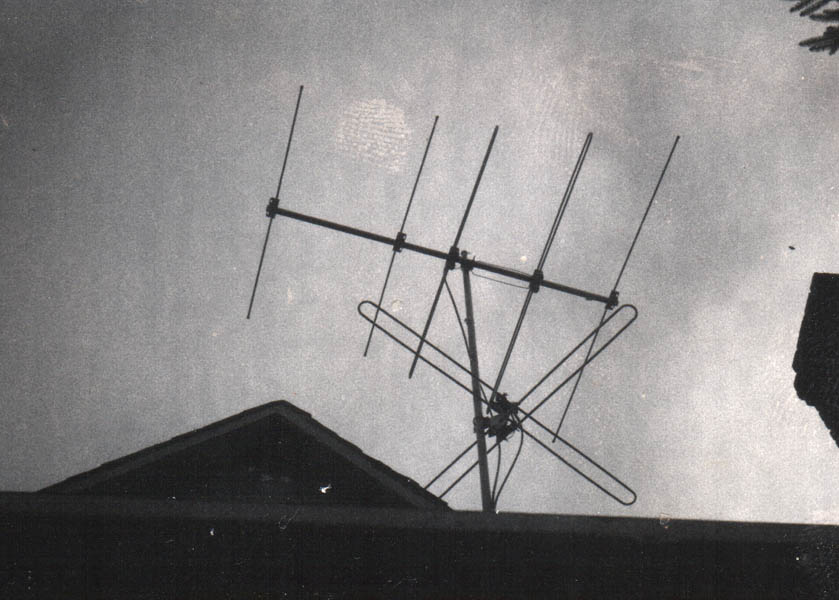
My first FM antenna, March 1978. This antenna started the "DXing" era for myself and several friends who also subsequently got FM antennas. Below the 5 element beam is an omni directional FM antenna.
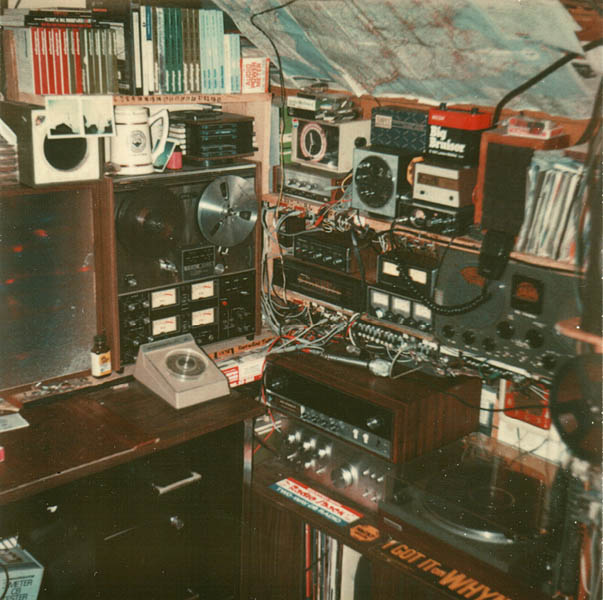
May 1978. A new (used) Heathkit AJ-15 FM tuner has been added, this was a vast improvement over the old Harmon Kardon tube (mono) tuner I was using previously. I earned the $$ for this unit (bought it used from a high school classmate) by working for people in the neighborhood. This tuner, coupled with the FM beam, allowed for many, many FM stations to be received, it was a major step up from the old Harmon Kardon unit. Note the rotor for the antenna on the desk. Also, a Radio Shack color organ is now mounted next the TEAC recorder. Note the addition of the Radio Shack SA-10 amplifier (just above the Harmon Kardon tuner). This amp was to replace the other Radio Shack amp I was using for the bugging system. During the summer of 1977, a very violent thunderstorm hit the northeast US and knocked power out for all of New York city and much of the other southern New England states. This same storm took out the bugging system amp. A voltage surge (from wires I had strung about 500 feet to the back of the property) blew the output stage of the amp. I took the amp to Radio Shack but they wanted like $30 just to look at it (that is a LOT of $$ for a teen in 1977). So, this amp was out of service for a while, however I long ago repaired it myself (after learning more about electronics). It is in service to this day. The system corner is very full now!
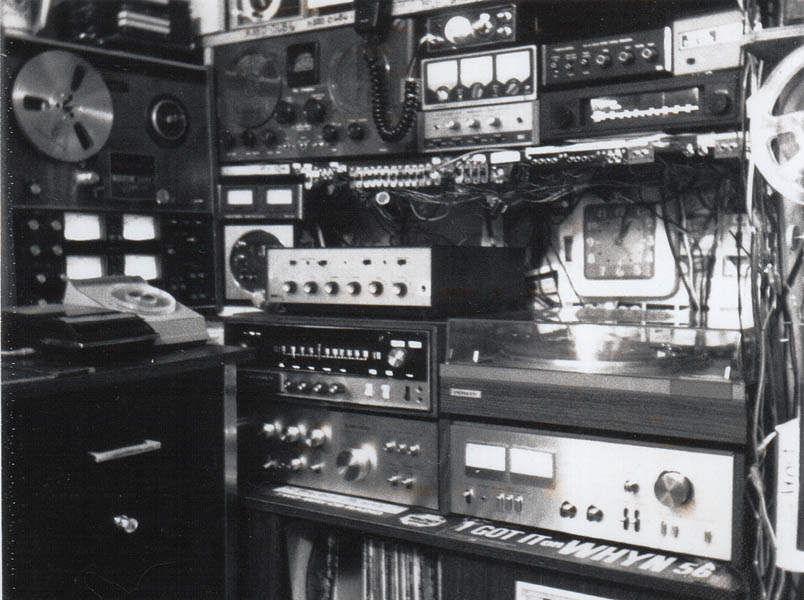
December 1978. A new Technics SU-7300 amp has been added, this helped the power shortage for all the speakers. Also still in use is the old Harmon Kardon amp. Total system power now was just under 100 watts per channel with all amps combined. That does not sound like a lot of power by today's standards, but it was a significant amount to have as a kid in the 70's! Also added are SWR and power meters for the CB as well as a new amp for the bugging system.
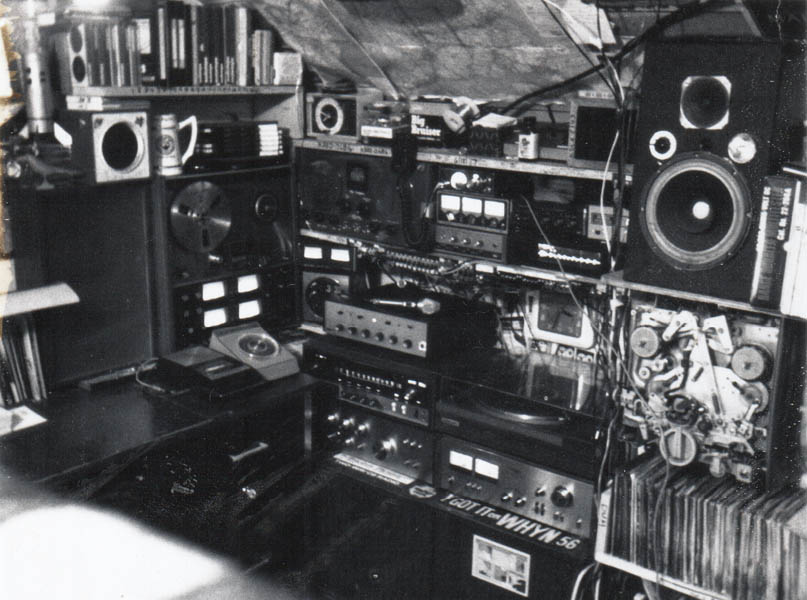
January 1979. This photo pretty much represents the peak of the development of my system in this bedroom. Sitting at the "controls" here gave the feeling of being in the control room of a submarine the way that I was surrounded by electronics. The setting was made especially cool with all the room lights off... the glow of many meters and indicators looked especially cool. Many long hours were spent fooling with the gear in this setup. I would stay up until late hours, talking to people on the CB while simultaneously listening to music and watching TV. People used to tell me "you need to get out more" until they saw this room... then they understood why I wanted to stay home and hang out! I have many fond memories of the time I spent in this room. Later in 1979 I moved to another new bedroom, and the system shown here was dismantled and moved. Although the system in the new bedroom was technically improved in terms of power, features and fidelity, it never had the same "feel" as the system in the corner of this room. It was the beginning of the end of an era.
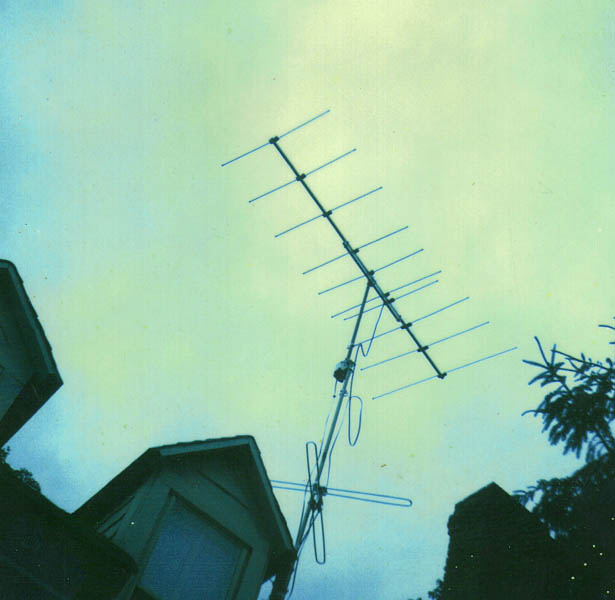
June 1979. A shot of a larger FM antenna used for DXing. I eventually had two of these antennas on the roof. We tried stacking them for even more gain, however this did not work out. Nonetheless, one of these antennas did quite a good job at pulling in stations.
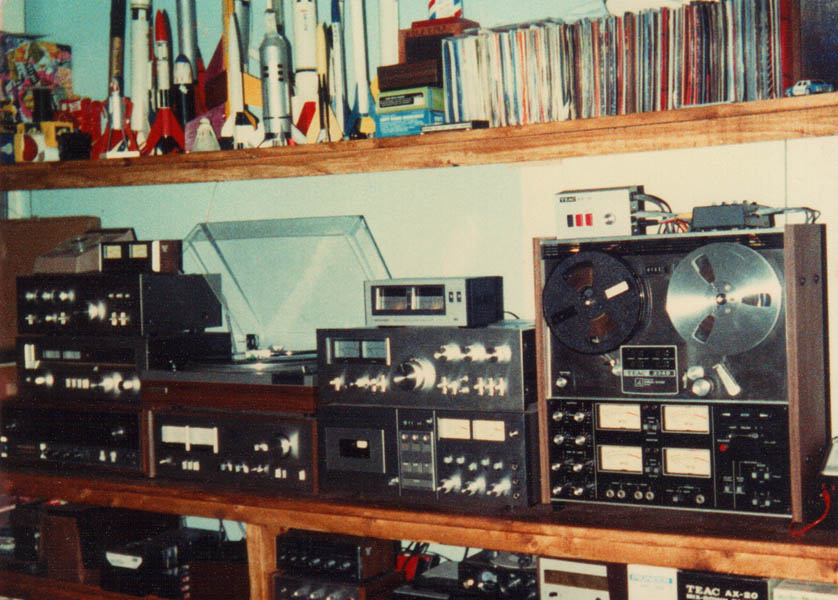
A view of the system in the new room (late 1979). Several new components have been added (a Kenwood KA-9100 amp, a TEAC A650 cassette deck, and a Nikko NT-850 tuner). I got my first job in the summer of 1979 (and one with pretty good pay) and this allowed me to purchase the Kenwood, the Nikko and the Teac. Not shown here, there are 12 " woofers mounted in thin cabinets under the bed. These were driven by one of the amplifiers with the bass cranked all the way up, the result was a floor that vibrated quite a bit (fortunately this room was on the ground level and no one lived in the basement below!). With the Kenwood the total system power was up to 342 watts, this system ROCKED.
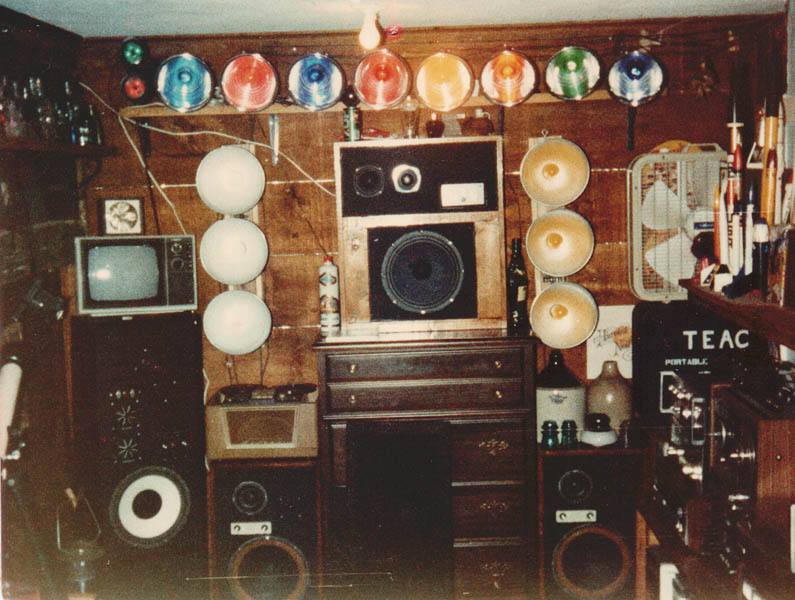
October 1980. A view of the south wall of the new room. The most notable addition here is the light show and a new set of speakers (also homemade). Total system power is now 342 watts. Still modest by today's standards, but it was quite substantial for 1980. In 1995 I had a system with 2,200 watts of power... THAT system can shake a concrete floor! Someday I'll add some photos of that gear (it includes 4 JBL 18" subwoofers).
So....
That is the quick story of how I became involved in electronics!
E-mail to Joe
Roberts
Images and HTML text © Copyright 1998 by Jo
e Roberts. Please request permission to use photos for purposes other than "personal use".

























